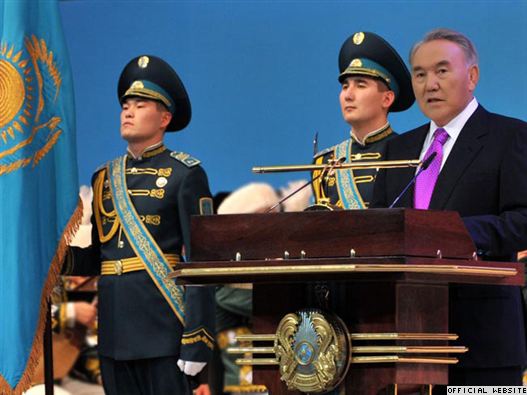
Kazakhstan’s Presidency Initiates Discussion On Political Reforms
Publication: Eurasia Daily Monitor Volume: 8 Issue: 74
By:

Reelected on April 3 (“A close-up view of Kazakhstan’s presidential election,” EDM, April 4), President Nursultan Nazarbayev intends to oversee a cautious transition to political and institutional pluralism in Kazakhstan during this five-year presidential term.
In Kazakhstan’s circumstances, a successful orderly transition to democracy necessitates gradual implementation from above. The historical experience of Western Europe, which underwent this transition during the nineteenth century (and Turkey’s in the twentieth), is one of elite-guided evolution over time, toward an ultimately democratic outcome. Relatively closer to Kazakhstan in time and circumstances, post-Soviet Ukraine and Moldova provide cautionary examples of multi-party systems and parliamentary government that were introduced prematurely, even on European soil, without a proper institutional and social base.
Following the presidential election, Nazarbayev completed the nominations to the cabinet of ministers on April 14, largely in its former composition (Kazinform, April 14). Personnel continuity spells policy continuity as outlined in Nazarbayev’s reelection platform. Top priorities include reform of the judiciary, systematic anti-corruption efforts, and the election of a pluralist Majlis (lower house of parliament) by 2012 in place of the incumbent, single-party Majlis, Significantly, Nazarbayev correlates the anti-corruption efforts explicitly with the protection of private property rights.
Installing the new Internal Affairs Minister, Kalmukhambet Kasymov, in his post, Nazarbayev assigned the ministry’s senior staff the twin tasks of combating corruption within law-enforcement agencies and extortionist pressures on businessmen. Nazarbayev called for an end to those agencies’ extra-legal intrusion into the economic sphere: “Cut down on the control apparatus, give business a free rein” (Khabar, April 12).
Promoting the development of a middle class in Kazakhstan is a presidential policy objective. As Nazarbayev’s reelection platform anticipated, the government is drafting a privatization program to create small shareholders in state enterprises, Dubbed a “People’s IPO [initial public offering]” and “people’s capitalism,” this is envisaged as the first stage in the privatization of state enterprises. Outside the state sector, the government aims to stimulate small and medium-size enterprises, the social effect of which would be to create a middle-class base for political development in Kazakhstan. According to Nazarbayev in his re-inauguration address, small and medium-size enterprises in the non-oil sector should account for as much as 40 percent of GDP by 2020, which would imply the emergence of a sizeable middle class in Kazakhstan (Khabar TV, April 8).
On the parliamentary level, Kazakhstan has certain safeguards of stability in place that historians of nineteenth century continental Europe would recognize: a bicameral parliament with an appointive Senate and a five-year rotation cycle, as well as a powerful head of state, to whom the cabinet of ministers is accountable. As a further safeguard, the threshold for parties to be represented in parliament is set high at seven percent of the votes cast.
Nazarbaeyev’s top political adviser, Yermukhamet Yertysbayev, is a more forward-leaning proponent of reforms in the presidential team. The day after the president’s reelection, Yertysbayev suggested asking the Majlis to vote for its own dissolution, so as to authorize pre-term parliamentary elections this year, leading to the election of a pluralist Majlis. Nazarbayev weighed in, clarifying that the parliamentary elections would be held on the constitutional schedule in 2012 (Khabar, April 4, 8).
Yertysbayev proposes the creation of a two-party system in Kazakhstan, inspired by the two party systems of the United States (Republican, Democratic) and formerly of Britain (Conservative, Labor), in the interest of stability and predictability. In Kazakhstan, such a system would include the already existing Nur Otan as a “party of power,” and Ata Meken to be created as a party of business. In this scheme, Nur Otan would function as a “naturally conservative” party representing political elites and the mass of state employees. Ata Meken would represent the interests of a growing entrepreneurial class, promoting liberalization of the economy and of legislation.
Further in this scheme, Nur Otan and Ata Meken would reciprocally monitor the legality and propriety of each other’s activities through parliamentary mechanisms in the new Majlis. According to Yertysbayev, a two-party system along these lines would separate political power from business interests, eliminating the “feeding ground for corruption” that had resulted from their merger. Kazakhstan’s already existing political parties would be given the opportunity to unite either with Nur Otan or with Ata Meken (Interfax, April 5, 11).
Other proposals from within Nur Otan would create a two-party system by dividing that party of power into a conservative and a liberal party. Apart from Nur Otan there are nine small parties legally registered in Kazakhstan, none represented in parliament, and three of whom define themselves as opposition. Most of the nine groups look more like political projects than parties. At least one party, Auyl, aspires to represent specific economic interests –in this case, commercially-oriented agriculture.
These parties take the position that the incumbent Majlis does not reflect the diversity of political views in Kazakhstan, hence new elections should ensure representation of that spectrum in a multi-party Majlis. The debate at this stage seems to involve the pace and degree of opening up the next Majlis: whether in 2011 or 2012, and whether two-party or multi-party. However, a strong majority party remains indispensable to an orderly process of political reforms.




